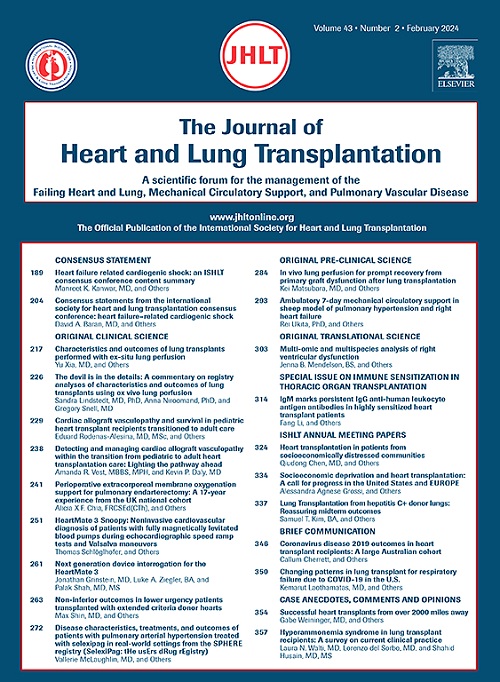桥接移植 ECMO 后的三年结果 - 2018 年 UNOS 修订版心脏分配系统前后。
IF 6.4
1区 医学
Q1 CARDIAC & CARDIOVASCULAR SYSTEMS
引用次数: 0
摘要
背景:根据器官共享联合网络(UNOS)修订后的供体心脏分配系统,自2018年10月以来,作为心脏移植(HT)桥梁的临时机械循环支持(包括静脉-动脉体外膜肺氧合(VA-ECMO))的使用率显著增加。修订后的心脏分配系统旨在降低需要双心室、不可出院、机械循环支持的重症患者的等待时间和死亡率。虽然之前的报告显示,在当前的 Era 中,HT 后 1 年生存率有所提高,但对于桥接移植(BTT)ECMO 患者的 3 年生存率以及与死亡率相关的因素却没有很好的描述:我们查询了 UNOS 数据库中 2010 年至 2019 年期间进行的所有成人(年龄≥ 18 岁)纯心脏移植手术。根据患者的 HT 日期,将其分为分配前(2010 年 1 月至 2018 年 9 月;时代 1)或分配变化后(2018 年 11 月至 2019 年 12 月;时代 2)队列。比较了基线受者特征和移植后结果。进行了 Cox 回归分析,以探究 Era 2 中 BTT-ECMO 患者 3 年死亡率的风险因素。在每个时代,还比较了BTT-ECMO患者和无ECMO支持移植患者的3年死亡率:在研究期间,第一纪元有 116 名患者接受了 BTT ECMO,第二纪元有 154 名患者接受了 BTT ECMO。两组受者的基线特征相似。第二组的中位年龄为 48(36-58 IQR)岁,而第一组为 51(27-58 IQR)岁。在时代 2 和时代 1 中,大多数 BTT-ECMO 患者为男性(77.7% vs 71.5%,P = 0.28)。在时代 2 中,列为 HT 的 ECMO 运行时间中位数明显缩短(4 天 vs 7 天,p < 0.001)。第二代 BTT ECMO 患者的候诊死亡率也明显降低(6.3% vs 19.3%,p < 0.001)。与 Era 1 相比,Era 2 的 HT 后 6 个月存活率(94.2% vs 75.9%,p < 0.001)、1 年存活率(90.3% vs 74.2%,p < 0.001)和 3 年存活率(87% vs 66.4%,p < 0.001)均显著提高。与时代 1 相比,时代 2 的移植失败率在 1 年(10.3% vs 25.8%,p = 0.0006)和 3 年(13.6% vs 33.6%,p=0.0001)也明显降低。年代 2 的 BTT ECMO 患者的 3 年生存率与年代 2 未接受 ECMO 支持的移植患者相似(87% vs 85.7%,p=0.75)。在对时代 2 的 BTT-ECMO 患者进行的多变量分析中,体重指数(BMI)每增加 1 kg/m2 与 3 年死亡率升高有关(HR 1.09,95% CI 1.02-1.15,p = 0.006)。同样,HT 后中风(HR 5.58,95% CI 2.57-12.14,p <0.001)和 HT 后肾功能衰竭需要血液透析(HR 4.36,95% CI 2.43-7.82,p <0.001)也与 3 年死亡率有关:结论:与之前的系统相比,在修订后的供体心脏分配系统下,ECMO 桥接患者术后三年的存活率明显提高。在修订后的系统下,BTT ECMO 受者的 ECMO 候诊时间明显缩短,候诊死亡率降低,3 年生存率与未进行 ECMO 桥接的受者相似。总体而言,修订后的分配制度使病情最严重的患者得到了更快速的移植,同时又不会增加移植后死亡率。本文章由计算机程序翻译,如有差异,请以英文原文为准。
Three-year outcomes after bridge to transplantation ECMO—pre- and post-2018 UNOS revised heart allocation system
Background
Utilization of temporary mechanical circulatory support, including veno-arterial extra-corporeal membrane oxygenation as a bridge to heart transplantation (HT) has increased significantly under the revised United Network for Organ Sharing (UNOS) donor heart allocation system. The revised heart allocation system aimed to lower waitlist times and mortality for the most critically ill patients requiring biventricular, nondischargeable, mechanical circulatory support. While previous reports have shown improved 1-year post-HT survival in the current era, 3-year survival and factors associated with mortality among bridge-to-transplant (BTT) extra-corporeal membrane oxygenation (ECMO) patients are not well described.
Methods
We queried the UNOS database for all adult (age ≥ 18 years) heart-only transplants performed between 2010 and 2019. Patients were stratified as either pre- (January 2010-September 2018; era 1) or post-allocation change (November 2018-December 2019; era 2) cohort based on their HT date. Baseline recipient characteristics and post-transplant outcomes were compared. A Cox regression analysis was performed to explore risk factors for 3-year mortality among BTT-ECMO patients in era 2. For each era, 3-year mortality was also compared between BTT ECMO patients and those transplanted without ECMO support.
Results
During the study period, 116 patients were BTT ECMO during era 1 and 154 patients during era 2. Baseline recipient characteristics were similar in both groups. Median age was 48 (36-58 interquartile range (IQR)) years in era 2, while it was 51 (27-58 IQR) years in era 1. The majority of BTT-ECMO patients were males in both era 2 and era 1 (77.7% vs 71.5%, p = 0.28). Median ECMO run times while listed for HT were significantly shorter (4 days vs 7 days, p < 0.001) in era 2. Waitlist mortality among BTT ECMO patients was also significantly lower in era 2 (6.3% vs 19.3%, p < 0.001). Post-HT survival at 6 months (94.2% vs 75.9%, p < 0.001), 1 year (90.3% vs 74.2%, p < 0.001), and 3 years (87% vs 66.4%, p < 0.001) was significantly improved in era 2 as compared to era 1. Graft failure at 1 year (10.3% vs 25.8%, p = 0.0006) and 3 years (13.6% vs 33.6%, p = 0.0001) was also significantly lower in era 2 compared to era 1. Three-year survival among BTT ECMO patients in era 2 was similar to that of patients transplanted in era 2 without ECMO support (87% vs 85.7%, p = 0.75). In multivariable analysis of BTT-ECMO patients in era 2, every 1 kg/m2 increase in body mass index was associated with higher mortality at 3 years (hazard ratio (HR) 1.09, 95% CI 1.02-1.15, p = 0.006). Similarly, both post-HT stroke (HR 5.58, 95% CI 2.57-12.14, p < 0.001) and post-HT renal failure requiring hemodialysis (HR 4.36, 95% CI 2.43-7.82, p < 0.001) were also associated with 3-year mortality.
Conclusions
Three years post-HT survival in patients bridged with ECMO has significantly improved under the revised donor heart allocation system compared to prior system. BTT ECMO recipients under the revised system have significantly shorter ECMO waitlist run times, lower waitlist mortality and 3-year survival similar to those not bridged with ECMO. Overall, the revised allocation system has allowed more rapid transplantation of the sickest patients without a higher post-HT mortality.
求助全文
通过发布文献求助,成功后即可免费获取论文全文。
去求助
来源期刊
CiteScore
10.10
自引率
6.70%
发文量
1667
审稿时长
69 days
期刊介绍:
The Journal of Heart and Lung Transplantation, the official publication of the International Society for Heart and Lung Transplantation, brings readers essential scholarly and timely information in the field of cardio-pulmonary transplantation, mechanical and biological support of the failing heart, advanced lung disease (including pulmonary vascular disease) and cell replacement therapy. Importantly, the journal also serves as a medium of communication of pre-clinical sciences in all these rapidly expanding areas.

 求助内容:
求助内容: 应助结果提醒方式:
应助结果提醒方式:


